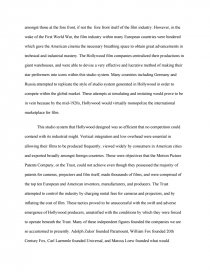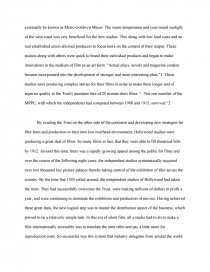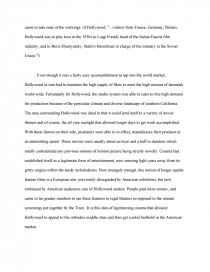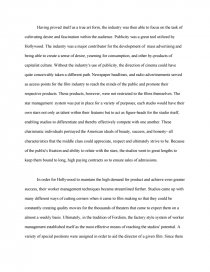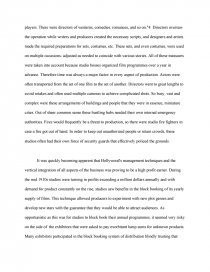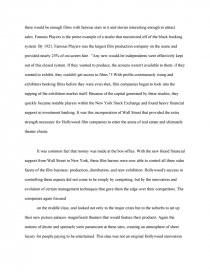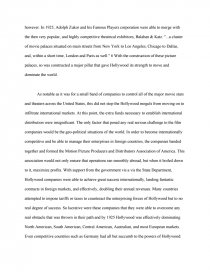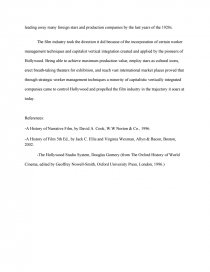Film History in the Silent Era - the Worker Management Techniques and Capitalist Vertical Integration
Essay by review • December 16, 2010 • Research Paper • 2,894 Words (12 Pages) • 2,322 Views
Essay Preview: Film History in the Silent Era - the Worker Management Techniques and Capitalist Vertical Integration
Film History In the Silent Era:
The Worker Management Techniques
and Capitalist Vertical Integration
Within Hollywood
By Phil Beauregard
The film industry would have never taken the direction it did without the incorporation of certain worker management techniques and capitalist vertical integration pioneered by the founders of Hollywood. The methods of operation that Hollywood established in the realms of production, manufacturing, exhibition and distribution of film has shaped the face of the industry to how we recognize it today.
In the warm, sunny outskirts of Los Angeles lay Hollywood. This was the location of choice for several enterprising film companies in the early 1910s to settle and establish themselves away from the cold winters of New York, the headquarters of the Motion Picture Patent's Company known as the Trust. By the time of the Great Depression, this small band of independent entrepreneurs would demonstrate that by applying certain worker management techniques within a capitalist vertical integration system, near absolute control of the film industry could be achieved. Prior to the domination of Hollywood, French film making was amongst those at the fore front, if not the fore front itself of the film industry. However, in the wake of the First World War, the film industry within many European countries were hindered which gave the American cinema the necessary breathing space to obtain great advancements in technical and industrial mastery. The Hollywood film companies centralized their productions in giant warehouses, and were able to devise a very effective and lucrative method of making their star performers into icons within this studio system. Many countries including Germany and Russia attempted to replicate the style of studio system generated in Hollywood in order to compete within the global market. These attempts at simulating and imitating would prove to be in vein because by the mid-1920s, Hollywood would virtually monopolize the international marketplace for film.
This studio system that Hollywood designed was so efficient that no competition could contend with its industrial might. Vertical integration and low overhead were essential in allowing their films to be produced frequently, viewed widely by consumers in American cities and exported broadly amongst foreign countries. These were objectives that the Motion Picture Patents Company, or the Trust, could not achieve even though they possessed the majority of patents for cameras, projectors and film itself, made thousands of films, and were comprised of the top ten European and American inventors, manufacturers, and producers. The Trust attempted to control the industry by charging rental fees for cameras and projectors, and by inflating the cost of film. These tactics proved to be unsuccessful with the swift and adverse emergence of Hollywood producers, unsatisfied with the conditions by which they were forced to operate beneath the Trust. Many of these independent figures founded the companies we are so accustomed to presently. Adolph Zukor founded Paramount, William Fox founded 20th Century Fox, Carl Laemmle founded Universal, and Marcus Loew founded what would eventually be known as Metro Goldwyn Mayer. The warm temperature and year-round sunlight of the west coast was very beneficial for the new studios. This along with low land costs and no real established union allowed producers to focus more on the content of their output. These studios along with others were quick to brand their individual products and began to make innovations in the medium of film as an art form. "Actual plays, novels and magazine content became incorporated into the development of stronger and more interesting plots."1 These studios were producing complex stories for their films in order to make them longer and of superior quality to the Trust's mundane fare of 20 minute short films. "...Not one member of the MPPC, with which the independents had competed between 1908 and 1915, survived."2
By evading the Trust on the other side of the continent and developing new strategies for film form and production in their new low overhead environment, Hollywood studios were producing a great deal of films. So many films in fact, that they were able to fill theatrical bills by 1912. Around this time, there was a rapidly growing appeal among the public for films and over the course of the following eight years, the independent studios systematically acquired over two thousand key picture palaces thereby taking control of the exhibition of film across the country. By the time that 1920 rolled around, the independent studios of Hollywood had taken the reins. They had successfully overcome the Trust, were making millions of dollars in profit a year, and were continuing to dominate the exhibition and production of movies. Having achieved these great feats, the next logical step was to master the distribution aspect of the business, which proved to be a relatively simple task. In this era of silent film, all a studio had to do to make a film internationally accessible was to translate the inter titles and pay a little more for reproduction costs. So successful was this system that industry delegates from around the world came to take note of the workings of Hollywood. "...visitors from France, Germany, Britain, Hollywood was to play host in the 1930s to Luigi Freddi, head of the Italian Fascist film industry, and to Boris Shumyatsky, Stalin's Henchman in charge of the industry in the Soviet Union."3
Even though it was a fairly easy accomplishment to tap into the world market, Hollywood in turn had to maintain the high supply of films to meet the high amount of demands world-wide. Fortunately for Hollywood, the studio system was able to cater to this high demand for production because of the particular climate and diverse landscape of southern California. The area surrounding Hollywood was ideal in that it could lend itself to a variety of movie themes and of course, the all year sunlight that allowed longer days to get work accomplished. With these factors on their side, producers were able to in effect, manufacture their products at an astonishing speed. These movies were usually about an hour and a half in duration which totally contradicted any previous notions of motion picture being strictly novelty. Cinema had established itself as a legitimate form of entertainment, now seeming light years away from
...
...

